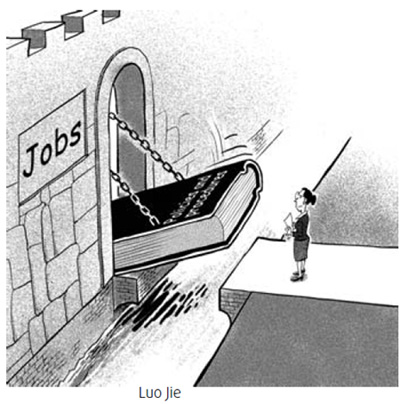Debate: Gender equality

Editor: China has come a long way in gender equality and has been moving toward achieving the UN Millennium Development Goals, but problems still remain. A professor and a journalist analyze those problems and the prospects the future holds.
How to rise up to gender equality challenge
In May 2005, 74 of the 100 women answering a questionnaire said they had been victims of gender discrimination.
In June 2008, the Center for Women's Law and Legal Services of Peking University handed over 3,000 copies of a questionnaire to employees in Beijing, Changsha and Kunming. The questionnaire was prepared under the university's "anti-gender discrimination at China's workplace" project. And only 23.6 percent of the 2,707 valid respondents said they had been discriminated against for being women.

This shows the Law on the Promotion of Employment, which came into force in 2008, has helped lessen gender discrimination at workplaces. But gender discrimination still exists despite the progress.
For instance, most of the employers have changed their strategy from direct refusal to implicit discrimination. They set different criteria for men and women, and ask woman applicants tougher questions. Some of the questions put to women, like whether they can drink, sing and dance, and whether they have a boyfriend and when do they plan to get married, have no relevance whatsoever to the job. Some employers still write clauses in job contracts, forbidding woman employees from getting married, or conceiving, or taking maternity leave. In some enterprises, men and women doing the same work are paid differently, and promotion procedures favor men. Sometimes women are forced to live away from their husbands, and some are even forced to retire earlier than men.
But far worse than all this is institutional discrimination. For example, a national regulation says that only people who have worked for at least 35 years can draw 90 percent of their salary as pension. People who have worked for less than 35 years can get only 85 percent, and those with less than 30 years of work, only 80 percent. So if a woman professor, academic or civil servant wants to draw 90 percent of her salary as pension after retirement, she has to start work at or before reaching the age of 20 because the mandatory retirement age for women is 55.
A survey conducted under the "anti gender discrimination at China's workplace" project shows that when women face gender discrimination in employment, 25.6 percent of them choose to endure it, 26.5 percent take it up with their employers, 32.4 percent complain to relevant government departments, and only 16.9 percent decide to move court.
Based on academic research and judicial practices, I see the following as the major hurdles on the road to gender equality:
The first hurdle is the exclusion of gender discrimination from the range of civil courts' jurisdiction. Pension, for example, is determined by the amount paid as social security, length of employment and the savings in individual accounts. The later a person retires, the higher his/her pension will be.
The mandatory retirement ages for men (60 years) and women (55 for officials and 50 for workers), however, are different because of which woman employees of the same age and academic qualification get less pension than their male peers.
Since female education is improving but women's career is still shorter, early retirement affects women's promotion and acts as a hurdle in their career development. Because in practice an employee is considered for promotion only before five years of his/her retirement, it is more difficult for women to reach a decision-making level in an organization.
Civil courts usually reject complaints against gender discrimination in such cases saying they are beyond the range of their work. Since civil courts are the last resort for gender discrimination victims to get justice, by rejecting the complaints they stifle the voices of even women who dare to complain.
In 2008, I conducted an investigation into the healthcare system of Tangshan, Hebei province, and talked with 172 complainants who challenged their employers on retirement age. Woman professionals, including nurses and pharmacists, were forced to retire at 50 because their personal documents said they were "workers". And when they were "rehired after retirement", their average income fell by more than 2,000 yuan.
These women filed many petitions to get justice. Four of them moved court but none won the case. The court rejected the lawsuit of the first complainant, surnamed Han, because it "was not in the range of acceptance". The other three complainants' cases were rejected, too. In the end, the women resorted to administrative coordination to get the support of the government.
The second problem is linking class actions with mass incidents. I have acted as an agent in two labor disputes, each of which had 36 complainants. Though one plaint should have been enough to make the demand of all the complainants clear, the court ruled that they have to be divided into individual cases. It not only raised the costs of printing lawsuit materials and wasted precious judicial resources, but also broke up the group and gave the defendant the chance to win the cases against individual complainants one after another.
Overseas experience shows that class actions could benefit vulnerable people by unifying them against the stronger side. A famous example is the lawsuit filed by thousands of Dell Inc's woman employees, led by a former senior executive of the company.
In July, Dell announced that it had reached an agreement with the complainants to settle a gender discrimination class action taken by its former employees. Dell not only had to pay $9.1 million to the complainants, but also invited psychologists to evaluate its recruitment procedure and experts to suggest adjustments in woman employees' salaries. Had Dell employees filed individual lawsuits, the result could have been different. Stability can only be achieved by solving the problems we have, and it is arbitrary to link class actions with mass incidents.
Third, the lack of anti-discrimination law and the lack of adequate employment opportunities deter victims from trying to fight for their rights.
Though the 2005 amendment to the Law on the Protection of Rights and Interests of Women says equality between men and women is a basic national policy, there is still no explicit definition of discrimination, no special organization in charge of implementation, no clear legal responsibility, no rule to ensure witnesses' attendance and no regulation on preventing reprisal against complainants.
The absence of these necessary elements gives a victim little hope of winning a case in court. In practice, costs are usually higher than gains.
Hence, the government has to resolve all the above issues if it really wants to establish gender equality at workplaces.
The author is a professor at China Women's University, Beijing.
Reaching millennium goals is a tough task

By Wen Jia
One of the most difficult tasks for China is to find enough jobs and political seats for the eligible among its 660 million female population in just six years, long-laden as it is with poverty and lack of such a tradition.
Yet this is exactly what China is trying to do, and must do. China has to meet the eight UN Millennium Development Goals (MDGs) by 2015, the third of which is to "promote gender equality and empower women". This goal has three specifics: ratio of girls to boys in primary, secondary and tertiary education; share of women in wage employment in the non-agricultural sector; and proportion of seats held by women in parliament.
Meeting the education goal may not be a problem for China, but the other two are a different proposition. Women's advancement goes hand in hand with development, but the global economic slowdown has taken its toll on the job market, with more women than men losing their jobs. Even when the country is showing signs of recovery, discrimination against women in employment continues in some form or the other.
But discrimination against women is not exclusive to China. The International Labour Organization has projected that globally, 6.1 to 7.0 percent men but 6.5 to 7.4 percent women could be jobless this year.
Still, Khalid Malik, UN Resident Coordinator and UN Development Programme resident representative in China, perceived the brighter side when he said in August that Beijing was well on track to achieve the MDGs by 2015.
Women had had few political and economic rights in China for thousands of years. Things changed only 160 years ago during the Taiping Rebellion, when leaders of the Taiping Heavenly Kingdom (1851-64) introduced reforms, abolishing the practice of making women wear iron or wooden clogs, and employing them as officials and soldiers.
But the empowerment of women began in earnest in 1949 with the founding of the People's Republic of China. Article 6 of New China's ad-hoc constitution, the Common Program of the Chinese People's Political Consultative Conference (CPPCC), stipulated: Women enjoy equal rights with men in all aspects of life, including political, economic, cultural and education, and social fields.
If official data and releases are superficial, changes in social norms and understanding are profound. A number of daily expressions once characterized by male dominance have acquired favorable meanings for both sexes today. The term "giving you happiness" used to be a promise a groom made to the bride. Now it comes from both.
"The greatest event of life" or marriage is not a once-for-all settlement because more and more women are seeking divorce and remarrying. Men are no longer embarrassed to live with their wives' families. From having little or no authority, women today have risen to leadership positions.
But it is still a challenge to find jobs for all eligible women and further elevate their political status, even though the government has met the basic requirements of providing primary, secondary and higher education to female students. Woman professionals still face discrimination and suffer because of the sly distortions of law in the job market. Their mandatory age of retirement could be reconsidered.
Small and medium-sized businesses should be made to observe laws in safeguarding women's rights. Rural women still have the daunting dual task of attending to manual labor in the fields left by migrant male laborers and undergoing training not only in farming, but also in household care and processing sectors. So the government needs to spend more on women's further education and healthcare.
More women should be encouraged to take part in politics because even though they comprise 21.33 per cent of the deputies to the present NPC, against 20.24 percent in the 10th congress, the mark is still below the 22 percent first proposed in 2007. The percentage of woman members in the current CPPCC National Committee is even lower, about 18.
In comparison, women hold 30 percent or more of the single- or lower-chamber seats in 24 countries' parliament and 30 percent or more of the upper-chamber seats in 15 countries, according to the UN. Among the front-runners are developing countries in Africa, Asia and Latin America.
Just as Malik has said, China should raise gender equality to a whole new level on the basis of the progress made. And it can do that.
Promoting gender equality has been a basic national policy since the Fourth World Conference on Women in 1995 and an intrinsic element of a harmonious socialist society. China has one of the soundest mechanisms in the world to implement the 1995 "Beijing Platform for Action" and MDGs.
The National Working Committee on Children and Women is a special agency of the State Council to guide and supervise the work. It is composed of 33 ministries, commissions under the State Council and NGOs. Its working bodies extend to county-level cities, districts and banners across the country.
The committee has been carrying out the 2001-10 development program for women, and its focus is on women's roles in decision-making, economic participation, healthcare, law and the environment. It has broken down the MDGs and action plan into a comprehensive index system of hundreds of indicators that cover all walks of social and economic life. It gives each member unit the responsibility of fulfilling certain targets. And it takes up the arduous task of regularly evaluating the work and ensuring that the indicators are met.
Gender equality enjoys the support of a cross section of society. The All-China Women's Federation, All-China Federation of Trade Unions, Central Committee of the Communist Youth League, China Disabled Persons' Federation and China Association of Science and Technology all are pressing ahead with their gender equality work in urban and rural areas.
Legislatures at different levels and law enforcement agencies are demanding that women's rights be protected in every sphere of life, with the government enacting and revising a series of laws and administrative regulations in the past decade apart from dozens of new policies since 2005.
The Law on the Promotion of Employment, enforced on Jan 1, 2008, says "no employer unit should refuse to employ women or raise standards for women on the basis of gender, except in jobs or posts specified as improper for women by the State". It bans any unit from restricting woman employees from marrying or having a child.
Moreover, increasing global links and exchanges have opened the country to criticisms from across the globe, which in turn could become a stimulus for further guaranteeing women's rights. Another challenge is that China has to follow the international conventions it has signed on the protection of women's rights.
(China Daily 10/27/2009 page9)














